
bolewts58
-
Posts
600 -
Joined
-
Last visited
-
Days Won
9
Content Type
Profiles
Forums
Blogs
Gallery
Events
Store
Posts posted by bolewts58
-
-
It could be the sleeve insignia of the Freikorps Elisabeth.
A German dealer offers it:
What surprises me is that both your insignias show the very same conditions and stains (check several places)Did he just use your pictures?
Regards
Gilles
I don't know what this is. But, this is not FK Elisabeth. FK Elisabeth is completely different with much more fine detail than this poor quality skull.
0 -
you can find the letters R.M for Rudolf Mayer...and these ones are the originals
Rudolf Mayer (1846-1916) was the principal medal designer for the mint of B.H. Mayer, Pforzheim the original supplier of this medal. The medal with the suspension ring (Spangestück) is from a different die and therefore does not have the RM initials.
0 -
Military Passes with Freikorps service are hard to come by. I've managed to accumulate about 25 or so over the last few years.
This one is by far one of the rarest I've picked up.
Militärpass to Flieger Nicolaus Eberg who trained at the flying school at Halle beginning in late 1917, but who never actually saw action in WWI.
He was a volunteer pilot in the Freikorps, first stationed at Halle and later in the Baltic in Artillerie-Flieger-Staffel 101 of the famous Eiserne Flieger-Abteilung 427, part of the Iron Division. The pass includes a list of his campaign service in Riga and an ink stamp and notation of Eberg's air unit. The planes of Eis. Fl-Abt 427 flew mostly recon while the ground troops attacked Riga on May 22, 1919. Then later, they flew cover during the German retreat.
He served in the Riga campaign from May to July 1919 including the Battle of Riga, the Defence of the Düna River and the evacuation and retreat from Riga to Mitau after the Iron Division and the Baltische Landeswehr were forced out of Riga by the Estonians and their Latvian allies.
Eberg most certainly would have been eligible for the Iron Division Medal which was established in 1920.http://gmic.co.uk/uploads/monthly_01_2015/post-12700-0-72106400-1420855003.jpghttp://gmic.co.uk/uploads/monthly_01_2015/post-12700-0-93286200-1420855031.jpghttp://gmic.co.uk/uploads/monthly_01_2015/post-12700-0-08968500-1420855134.jpghttp://gmic.co.uk/uploads/monthly_01_2015/post-12700-0-76324700-1420855144.jpg
0 -
Here is a nice Wehrpass with the Bewährungsabzeichen des V. Armeekorps entered... I assume he was then told it did not count because in a later awards entry it is left out.....
Assuming because he was active Wehrmacht and the award had been banned in 1935. Interesting.
Just for interest's sake here's an award document for this award.
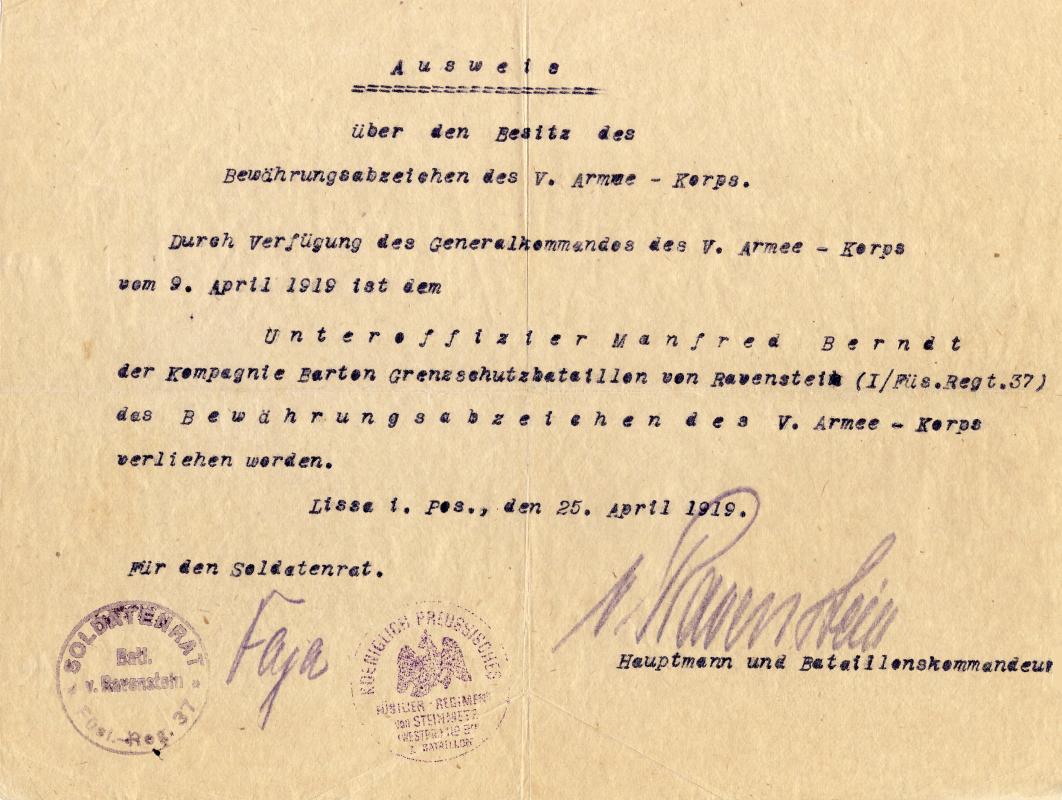 0
0 -
Hi,
I think, that the name is Franz
Meinem lieben
Kluckert zur
Erinnerung an die
gute Kameradschaft
Ihr Franz
Weihnachten 1937
Uwe
Yes. You're correct. my mistake.
0 -
The photo is to someone named Kluckert and from Heinrich Grauz, if I read it correctly. So, I assume he's Grauz. It's interesting that he's wearing the Freikorps cross in 1937 which was against regulations, it having been banned in 1935. This however happened quite a lot. Freikorps vets serving in the armed forces didn't want to give up their awards so easily, at least prior to the war.
Just for interest's sake, here's the Treukreuz from my collection.
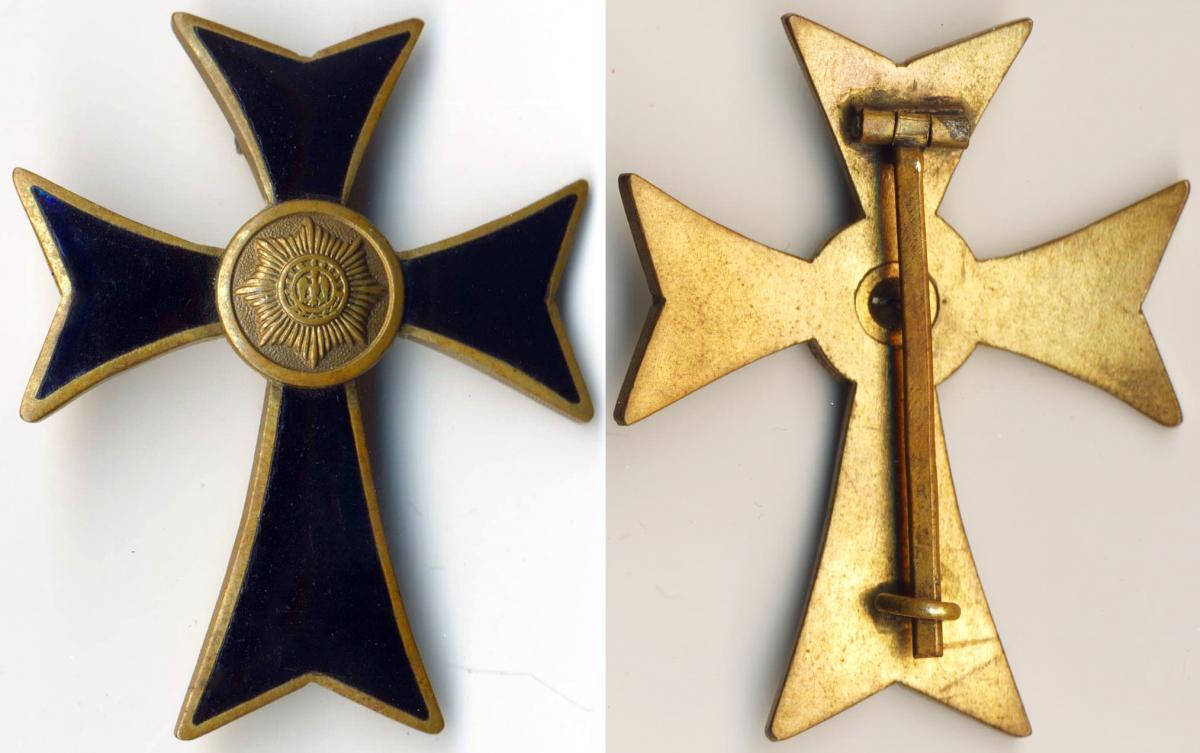 0
0 -
Does this one have a chance... ?
This was discussed at length on Feldgrau. It's considered either an outright fake or a modern re-design being awarded by David Bagrationi of Mukhrani, self-styled Prince of Georgia. In any case, the period ones were never made with rounded rays like this one. These turn up periodically in blue, or black with a red band.
IMO these are just fakes. The seller in question is not known for selling anything but fakes and is either an alternative name of the crooks in Aaachen or affiliated with them.
0 -
Similar item ................
Yes. But, much, much rarer.
0 -
Me too, Eric!!!
I´ve checked everything, but I couldn´t find out, what that "Sch" stands for. Maybe just "Schütze...
The 4.bavarian Reichswehr Inf.Rgt.46 came from the following Freikorps:
I.Bataillon Bamberg: Freikorps Bamberg (Regiment Leupold) and I.-III.Btl./Inf.Rgt.5 Bamberg
II.Bataillon Bamberg: Eiserne Schar Berthold (fränkisches Bauerndetachement)
III.Bataillon Bayreuth: Freikorps Bayreuth (bav. Inf.Rgt.7)
I don´t believe the "Sch" stands for "Schar" from the "Eiserne Schar" (Iron crowd) I don´t know if crowd is the right word for "Schar"...
I think that 'Schar' can be roughly translated as 'squad' or 'platoon'. I've seen the badge before. I'm pretty sure it's Freikorps. But, it's not documented.
0 -
Anyone any idea if these are both OK ??
There is an obvious difference in the bottom panels for the holder's number.
Left one is flat, right one is slightly convex.
Both look ok to me.
0 -
@ Thanks Ulstermann
@ bolewts58 I think that it is a reflection from the light and
nice photos. Thanks for sharing them with us
Kind regards
Andreas
Thanks. It's possibly a reflection as the photo is a little over-exposed. But, still I think there should some hint of black. It does look like white enamel to me. But, given the size of the image, it's hard to say for sure either way. Nice picture, though.
I just picked up these 2 nice cards of a member of Rw. Reiter Regt. 16 with the Silesian Eagle I and II and a submariner with the Baltic Cross.
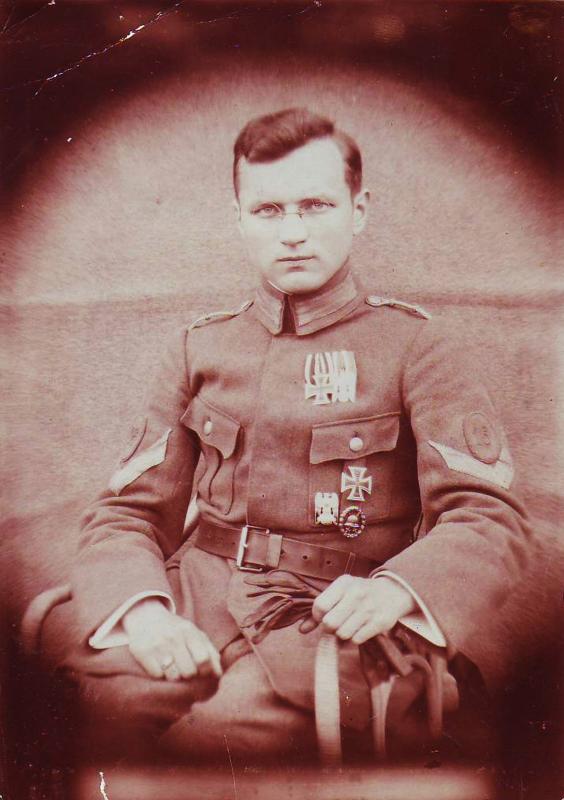
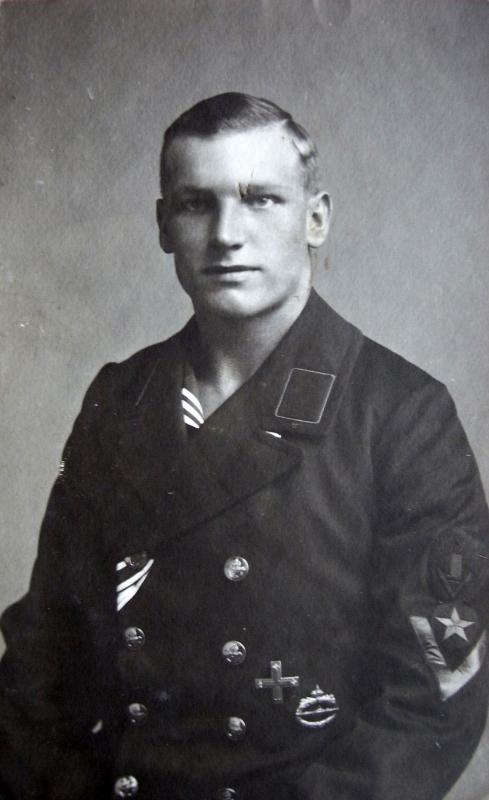 0
0 -
1/ Reichswehr soldier with Baltic Cross and 1st class of III Marine-Brigade (von Loewenfeld)
2/ Group shot of Reichswehr Sch. Regt. 4 wearing the Deutsch-Ordens-schild of Grenzschutz-Ost.
3/ Group Shot of Ehrhardt-Brigade 1. MGSS Abteilung, some wearing the Merit badge.
4. Soldier of Freiw. 12. Schlesien-Inf-Div. with Silesian Eagle 1st class.
http://gmic.co.uk/uploads/monthly_12_2014/post-12700-0-83956200-1418608878.jpghttp://gmic.co.uk/uploads/monthly_12_2014/post-12700-0-50784900-1418608887.jpghttp://gmic.co.uk/uploads/monthly_12_2014/post-12700-0-16460000-1418608918.jpghttp://gmic.co.uk/uploads/monthly_12_2014/post-12700-0-03794200-1418608939.jpghttp://gmic.co.uk/uploads/monthly_12_2014/post-12700-0-81456900-1418608949.jpghttp://gmic.co.uk/uploads/monthly_12_2014/post-12700-0-33140100-1418609338.jpg
0 -
The other soldier is wearing a ribbon bar with IC2, ?, ?, Baltenkreuz and Georgskreuz 4th class
and I think it is the Malteser - Kreuz ( Bermondt - Kreuz ) from Fürst Awaloff - Bermondt.
Regards
Andreas
The Malteser-Kreuz looks white in the photo. If so, it could be the Keller Cross, which was a Russian White Army award that some Germans in the Baltic received.
0 -
So ................... maybe this interpretation of your own photo best sums things up ...................... ??
I think they probably wore both; whichever one they had, especially the Freikorps vets from 1919-20. The guy in the photo above is likely an officer, which may also explain continuing to wear the large one. It's likely that the Verbande der SS took new recruits, as well who only wore the small one. The guy in the last photo looks too young to have been in the Freikorps. But, he may have joined the Wiking-Bund sometime in the 20s or early 30s. All in all, regulations of wear were probably still a bit fluid in 1933. Then, Ehrhardt went on the run after the Night of the Long Knives and the unit was forced to disband.
0 -
Detail russian wearing IC 1th class
Nice Russian West-Armee photo. But, I don't believe that's an iron Cross. I believe it's a Teutonic Order.
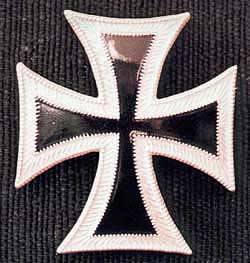 0
0 -
Bolewts58.
Many thanks.
I have learned a lot here!
You're welcome. I hope I didn't come off as too strident and long-winded. I'm a university professor and it sometimes is an occupational hazard.
By the way, the skull badge of the Ehrhardt Brigade Sturm-Kompagnie is a fantastic piece and extremely rare. Nice find.
0 -
I meant to add also that the font used on the Ehrhardt badge is classic old German Fraktur-type with the only modification being the flourishes on the bottom of the 'h's. The cut of the font on the original badges I've shown is precise and accurate. On your badge, as indicated before the type is wonky and obviously done by someone who does not understand typography. As my father was a typographer starting in the mid-30s and I have been a graphic designer and teacher for 40+ years, it's the first thing about this common fake I spotted.
0 -
Bolewts 58.
Thanks for your comments regarding the Ehrhardt badge.
I was under the impression that the badge I have was an original variant from the 1930s period, which has itself been faked, as per the photo below.
The top badge is struck, the bottom one is cast.
However, I stand to be corrected.
Your badge likely is die struck, but not genuine. There is also a die-struck fake of the 1st pattern Wilhelmshaven popping up periodically. It was determined by a number of experts several years ago that these were from comparatively recent cut dies and likely date back to the 1960s. The website Militaria Agent sells these well-made repros, as such, including yours for 30 Euros. The owner of the website told me a few years ago that he acquired the dies and copies of a number of Freikorps badges from a maker who produced these in the 1960s. Experienced, long-standing Freikorps collectors are all aware his story, as well.
Here is the link to exact same badge as yours on the Militaria Agent website:
https://www.militaria-agent.com/catalog/FREECORPS_EHRHARD_SHIELD_COLLECTORS_REPRODUCTION.html
There were several Freikorps reunions in the late 1950s and early 1960s; particularly by former members of Sturm-Abteilung Rossbach, III Marine-Brigade (von Loewenfeld) and the Ehrhardt Brigade. I know for example that von Loewenfeld gave out commemorative pins in the form of his Freikorps' original anchor and wreath collar badge, but with a different finish and a safety pin for attaching. It's possible that badges were reproduced for other reunions including that of the Ehrnardt veterans.
From the mid-1920s to 1934, the badge worn by the Wiking-Bund and then the Ehrhardt Brigade Verbande der SS was smaller (53-54 mm) than the Freikorps badge and a slightly different design. I've attached an example of the badge worn by the Ehrhardt Brigade Verbande der SS. Note particularly the bottom of the 'h' in 'Ehrhardt' ends in a small roundel instead of the long, extended curl of the FK badge. Many of the well-known dealers like Weitze, Phillipps, Beck, Hüsken have all misrepresented this smaller badge as a Prinzen variation of the Freikorps badge. They're all wrong. Ingo Haarcke, who arguably is one of the leading experts on Freikorps unit insignia correctly identifies it, in his very comprehensive catalogue, as the smaller badge worn by the Wiking-Bund and Ehrhardt Brigade Verbände der SS.
As there is a gap in the Freikorps record because the central archive of the Freikorps was badly damaged in a bombing raid in March 1945, there's a lot of spurious stuff and misinformation put out in the marketplace. Anytime a suspect item appears, the word "variation" is trotted out. In the case of the majority of Freikorps, they were so small and around for such a short time that there was no need for variations. In the case of larger and longer lasting Freikorps like II Marine-Brigade (Wilhelmshaven) (Ehrhardt), the variations are easily tracked and well-documented. There are 6 metal variations of the original Freikorps badge: 3 each of the 1st pattern (Wilhelmshaven) and 2nd pattern (Ehrhardt), plus a known privately-made example of an embroidered Ehrhardt version. When the Freikorps was resurrected in 1933 as a unit within the SS, a new smaller badge, as I have shown was struck and worn for about 1 year before they were disbanded. That's it. I truly don't believe there are any other hitherto unknown variations hiding in the woodwork waiting to miraculously appear.
I started researching and collecting Freikorps material in 1969. I think in the 1970s Verkuilen Ager and I were almost the only collectors of this material in North America beyond the TR guys buying Silesian Eagles and Baltic Crosses because they were in Angolia's book. There were not that many more collectors in Germany at that time either. While I wouldn't presume to call myself an expert, I've learned a thing or two in the last 45 years and am therefore 100% confident in my assessments with regards to your badge. The details and quality of original badges is simply not there.
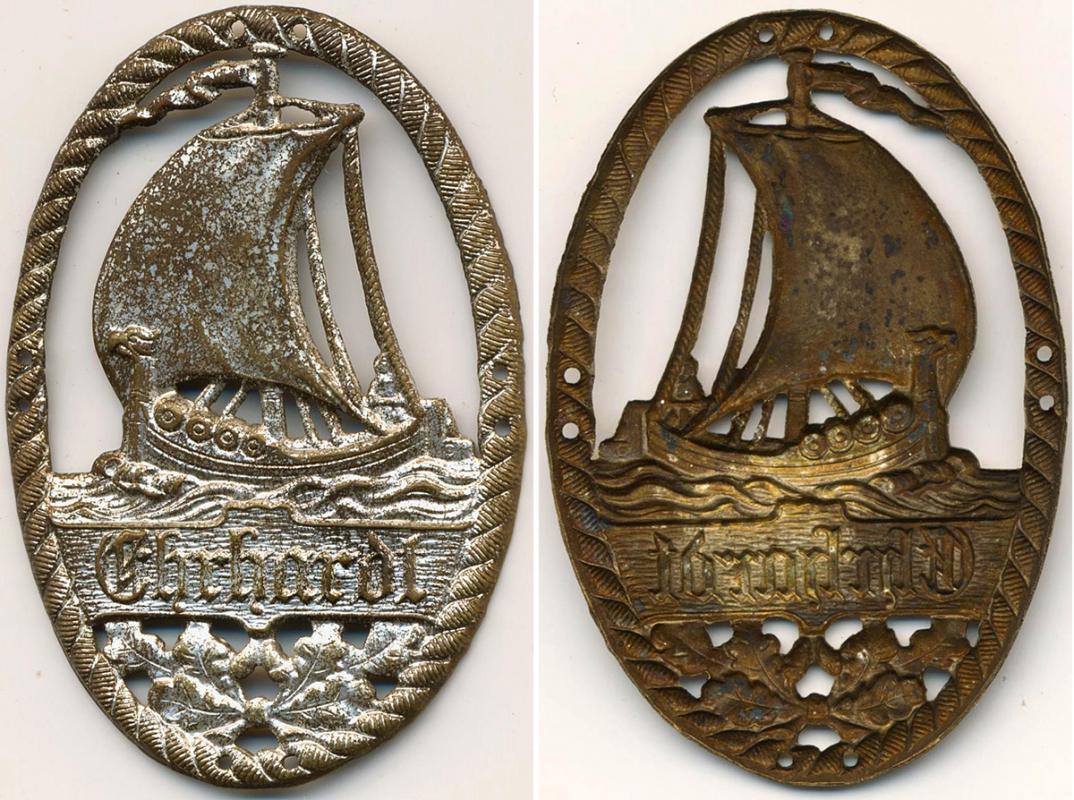 0
0 -
Robin, looks like I have a genuine one.
If it is, you can have it. I found it in a box of crap my great-aunt left behind.
Yes. That's a nice example.
0 -
A comparison of the genuine versus your fake clearly shows the discrepancies. Note also that the top of the cartouche on yours is badly done and asymmetrical. The mast and ropes on yours have no detail compared to the real one. Other obvious details are easy to pick out. Verkuilen Ager identified this fake at least 10 years ago as made from a completely different (and likely new) die. Whoever did it had little understanding of old German typography resulting in the glaring mistakes in the wonky lettering. One wonders whether the guy was drunk when he cut the letters.There are only 3 variations of the 2nd pattern as well as the smaller version made for the Viking-Bund. I'm sorry to say that yours is not one of them.
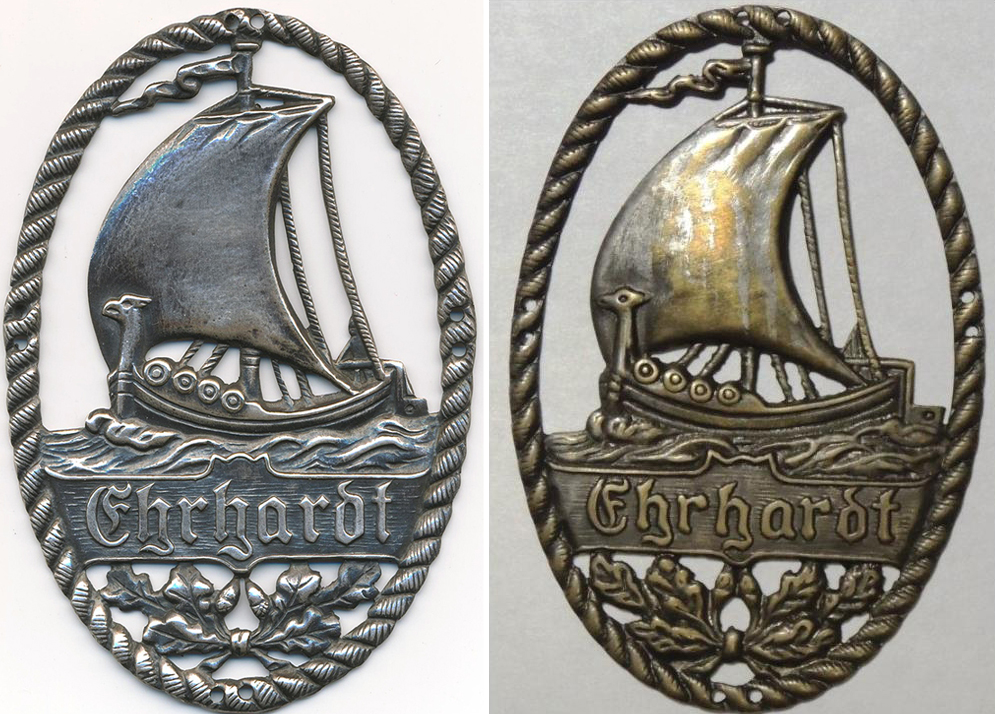 0
0 -
I've had this very distinctive type of skull for a few years.
Today, I managed to get the 'Viking Ship' sleeve badge to go with it.
Matching silvered brass insignia for the Sturmkompanie of the Ehrhardt Brigade, 1919-20.
I'm sorry to say that your 2nd Pattern Ehrhardt Brigade shield is a well-known fake noted by the lack of detail in the dragon's head on the bow, which looks more like a chicken, the missing helmsman's head, arm and body at the stern, the badly drawn and incorrect 'Ehrhardt' lettering and the overall slightly soft detail. Here are two genuine examples and the details of your fake example. The first of the genuine badges is the same type as yours with cutout oakleaves and holes for sewing and the 2nd is a variation with prongs and a backplate. Note the details of the helmsman, dragon head and lettering on both.
http://gmic.co.uk/uploads/monthly_12_2014/post-12700-0-73553800-1417751018.jpghttp://gmic.co.uk/uploads/monthly_12_2014/post-12700-0-39658600-1417751037.jpg
 0
0 -
- Freiwilligen Artillerie-Abteilung 39 -----> Sometimes that sub-unit is referred to as "Freiwilligen Batterie 39". Which name is correct?
According to the Truppenkartei Freiwilligenverbände 1918-1923- Deutsche Wehrkundearchiv, both are correct. They may have been separate units or it may be 2 names for the same unit. It's not clear.
The full title for both is:
Freiwilligen-Artillerie-Abteilung 39 Oberost
Freiwilligen-Artillerie-Batterie 39 Oberost
0 -
nobodies talking about these great badges anymore,,, is it because its me?
I managed to purchase this great photo off ebay, unusual for me I don't normally go after pictures but this is a nice shot anyway I'll post in case it gets lost in the mail etc.
Eric
This group is Freikorps. Although I'm not sure which one, as several wore chevrons like this as their unit insignia. I find it interesting that as has been discussed a couple of times on past threads, the backing cloth on the badges has been changed to black. This does seem to have been a common practice with Freikorps MG units, who continued to wear the badge.
0 -
I have determined that the ribbon on the SAII is actually for the Hannover Langensalza medal 1866. The wide trapazoid mount and the way in which the ribbon is sewn is very typical of the mid-19th century period.
So, someone artificially aged and distressed the SAII and put it with the genuine old ribbon making for a very convincing attempt to fool a collector.
This type of enamel eagle has been around for at least 20 years and only in recent years has it been identified as fake.
0


a rarity from the exclave of east prussia and danzig
in Germany: Weimar Republic & Deutsche Freikorps
Posted · Edited by bolewts58
That's the Tannenberg Denkmal in black on the obverse. AOR is the Arbeitsgemeinschaft Ostpreußische Regimentsvereine or Workers Union of East Prussian Regiments Associations. Hindenburg was the president and I remember reading somewhere that it was founded in 1927.